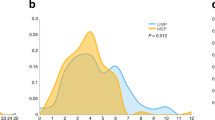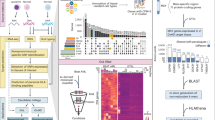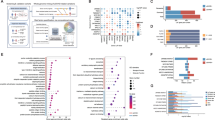Abstract
Incompatibility of minor histocompatibility antigen (mHa) is a major cause of acute graft-versus-host disease (GVHD) following bone marrow transplantation in human leukocyte antigen (HLA)-matched donor-recipient pairs. To avoid acute GVHD, as many mHa genes as possible need to be identified . In this study, we introduce a comparison of two proportions as an association test for detecting mHa genes in HLA-matched pairs with and without GVHD. Assuming multiple mHa loci, each with two alleles, we evaluated the effects of (1) minor allele frequency of the mHa locus of interest (denoted by p), and (2) probability of GVHD developing in a donor-recipient pair being incompatible at an mHa locus (denoted by r) on the powers of association tests for unrelated pairs and for sib pairs. Our results showed that based on a candidate gene approach, an mHa gene with high p and r values can be detected by the association test with a small sample size. Application of the present method to the Japanese population revealed that the association test for unrelated pairs is more suitable for detecting an mHa gene with a high r value than that for sib pairs. The present method will be helpful to researchers who evaluate the power of association study in advance.
Similar content being viewed by others
Log in or create a free account to read this content
Gain free access to this article, as well as selected content from this journal and more on nature.com
or
References
Behar E, Chao NJ, Hiraki DD, Krishnaswamy S, Brown BW, Zehnder JL, Grumet FC (1996) Polymorphism of adhesion molecule CD31 and its role in acute graft-versus-host disease. N Engl J Med 334:286–291
den Haan JMM, Meadows LM, Wang W, Pool J, Blokland E, Bishop TL, Reinhardus C, Shabanowitz J, Offringa R, Hunt DF, Engelhard VH, Goulmy E (1998) The minor histocompatibility antigen HA-14: A diallelic gene with a single amino acid polymorphism. Science 279:1054–1057
Goulmy E, Gratama JW, Blokland E, Zwaan FE, van Rood JJ (1983) A minor transplantation antigen detected by MHC-restricted cytotoxic T lymphocytes during graft-versus-host disease. Science 302:156–161
Hägglund H, Boström L, Remberger M, Ljungmann P, Nilsson B, Ringdén O (1995) Risk factors for acute graft-versus-host disease in 291 consecutive HLA-identical bone marrow transplant recipients. Bone Marrow Transplant 16:747–753
Jackson MR, Genin E, Knapp M, Escary JL (2002) Accurate power approximations for χ2-test in case-control association studies of complex disease genes. Ann Hum Genet 66:307–321
Kernan NA, Dupont B (1996) Minor histocompatibility antigens and marrow transplantation. N Engl J Med 334:323–324
Lunetta KL, Rogus J (1998) Strategy for mapping minor histocompatibility genes involved in graft-versus-host disease: A novel application of discordant sib pair methodology. Genet Epidemiol 15:595–607
Maruya E, Saji H, Seki S, Fujii Y, Kato K, Kai S, Hiraoka A, Kawa K, Hoshi Y, Ito K, Yokoyama S, Juji T (1998) Evidence that CD31, CD49b, and CD62L are immunodominant minor histocompatibility antigens in HLA identical sibling bone marrow transplants. Blood 92:2169–2176
Michallet M, Archimbaud E, Bandini G, Rowlings PA, Deeg H, Joachim H, Gahrton G, Montserrat E, Rozman C, Gratwohl A, Gale RP (1996) HLA-identical sibling bone marrow transplantation in young patients with chronic lymphocytic leukemia. Ann Intern Med 124:311–315
Nichols WC, Antin JH, Lunetta KL, Terry VH, Hertel CE, Wheatley MA, Arnold ND, Siemieniak DR, Boehnke M, Ginsburg D (1996) Polymorphism of adhesion molecule CD31 is not a significant risk factor for graft-versus-host disease. Blood 88:4429–4434
Ohashi J, Tokunaga K (2001) Power of genomewide association studies of complex disease genes: Statistical limitation of indirect approaches using SNP markers. J Hum Genet 46:478–482
Ohashi J, Tokunaga K (2002) The expected power of genome-wide linkage disequilibrium testing using single nucleotide polymorphism markers for detecting a low-frequency disease variant. Ann Hum Genet 66:297–306
Ohashi J, Tokunaga K (2003) The power of genome-wide linkage disequilibrium (LD) testing using microsatellite markers. J Hum Genet (in press)
Ohashi J, Yamamoto S, Tsuchiya N, Hatta Y, Komata T, Matsushita M, Tokunaga K (2001) Comparison of statistical power between 2 × 2 allele frequency and allele positivity tables in case-control studies of complex disease genes. Ann Hum Genet 65:197–206
Ohashi J, Maruya E, Tokunaga K, Saji H (2002) Linkage analysis of minor histocompatibility genes causing graft-versus-host-disease (GVHD) following allogeneic bone marrow transplantation. Am J Hum Genet 71[Suppl]:431
Risch N (1990) Linkage strategies for genetically complex traits. III. The effect of marker polymorphism on analysis of affected relative pairs. Am J Hum Genet 46:242–253
Schreuder GMT, Pool J, Blokland E, van Els C, Bakker A, van Rood JJ, Goulmy E (1993) A genetic analysis of human minor histocompatibility antigens demonstrates Mendelian segregation independent of HLA. Immunogenetics 38:98–105
Simpson E, Roopenian DC (1997) Minor histocompatibility antigens. Curr Opin Immunol 9:655–661
Wallny HJ, Rammensee HG (1990) Identification of classical minor histocompatibility antigen as cell-derived peptide. Nature 343:275–278
Acknowledgements
The authors appreciate an anonymous reviewer concerning improvements to this paper. This study was partly supported by a Grant-in-Aid for Scientific Research on Priority Areas (C), “Medical Science” from the Ministry of Education, Culture, Sports, Science and Technology, Japan (to J.O.), and the Genetic Diversity Project supported by the New Energy and Industrial Technology Development Organization (NEDO) (to J.O.).
Author information
Authors and Affiliations
Corresponding author
Additional information
An erratum to this article can be found at http://dx.doi.org/10.1007/s10038-003-0102-7
Rights and permissions
About this article
Cite this article
Ohashi, J., Maruya, E., Tokunaga, K. et al. Power of association test for detecting minor histocompatibility gene causing graft-versus-host disease following bone barrow transplantation. J Hum Genet 48, 502–507 (2003). https://doi.org/10.1007/s10038-003-0065-8
Received:
Accepted:
Published:
Issue date:
DOI: https://doi.org/10.1007/s10038-003-0065-8



